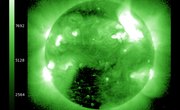
Solar flares erupt from the sun when its magnetic fields high above the plasma surface become twisted, break apart and reconnect. This phenomenon results in a massive explosion and the potential ejection of energized particles that are sent hurtling toward Earth. These charged particles can have a wide range of effects, from knocking out satellites to charging up the northern lights.
Effects on Satellites
Modern society relies on satellites for everything from telephone communications to GPS tracking, and a powerful solar flare could significantly disrupt or even destroy many satellites. Satellites in a high geosynchronous orbit could easily be damaged by a powerful electromagnetic current coming off the sun. Ultraviolet radiation from the flare event could also heat up the Earth's atmosphere, making it expand, which would result in an increased drag on orbiting satellites. This would result in either 'zombie satellites' that are no longer responsive to ground signals or satellites falling into Earth's atmosphere and burning up.
Damage to the Power Grid and Potential Aftermath
Although technology allows people to convert the sun's energy into electricity, that same source of energy is also capable of completely knocking out the energy grid, potentially leading to catastrophic conditions. Electromagnetic energy from a flare event is capable of charging the atmosphere. This phenomenon would in turn induce an abnormally high charge in power lines, blowing out both power transformers and stations. Destruction of the power grid would lead to many different kinds of problems for society, including a loss of ability to refrigerate food items and the breakdown of sewage and waste processing systems.
Aurora Borealis
In addition to affecting human activities, solar flare activity can also ramp up natural phenomena such as the aurora borealis. The aurora borealis light show can normally be seen for most of the year and is driven by the stream of particles constantly emanating from the sun. When these particles interact with the upper atmosphere, they excite molecules in the air, and when these molecules come back down to their unexcited state, they release visible light. When a powerful solar flare event sends a high amount of charged particles into the upper atmosphere, the aurora, which is normally visible only in higher latitudes, extends further south and is more active and more intense.
Increased Lightning Strikes
A highly charged atmosphere from a solar flare event can also have another natural consequence: increased lightning strikes. According to a 2014 report from researchers at the University of Reading, increased solar activity can lead to an increase in the number of lightning strikes. That research somewhat contradicts previous theories suggesting that cosmic radiation from supernovae is behind the rate of lightning strikes on Earth. The researchers from the 2014 study have said that their findings, along with previous knowledge about the sun, will allow them to predict lighting rates in great detail.
References
- Space Weather: Sunspots, Solar Flares & Coronal Mass Ejections - Space.com
- Space Weather: What impact do solar flares have on human activities? - NASA
- The dangers of solar storms: That which gives power can also take it away - Earth Magazine
- Incredible Footage of An Aurora Dancing in Real Time! - Slate
- Where Does Lightning Come From? (Video) - University of Reading
About the Author
Brett Smith is a science journalist based in Buffalo, N.Y. A graduate of the State University of New York - Buffalo, he has more than seven years of experience working in a professional laboratory setting.
Photo Credits
Muntxeta/iStock/Getty Images
